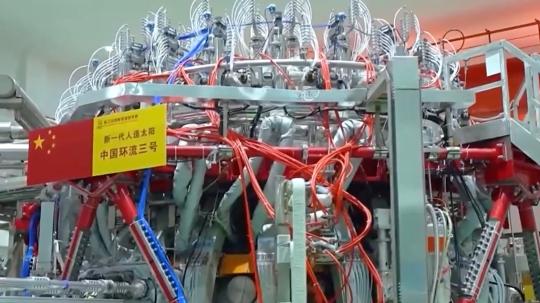
A view of China's self-developed Huanliu-3 nuclear fusion reactor, the country's new-generation "artificial sun". (Photo/CMG)
China made a breakthrough in controllable nuclear fusion technology on Saturday.
Huanliu-3, the country's new-generation "artificial sun," realized high-confinement mode operation with a plasma current of 1 million amperes for the first time, according to the China National Nuclear Corporation (CNNC).
The breakthrough puts the operational level of China's magnetic confinement nuclear fusion device at the forefront of the world, and is an important milestone in the country's development of nuclear fusion energy.
The Huanliu-3, independently developed by China, is a large-scale research facility for controllable nuclear fusion.
The high-confinement mode, or H-mode, is an advanced mode of operation in magnetic confinement fusion, which is more economical than the ordinary mode.
Thus, the H-mode has been chosen as the standard operation mode for the International Thermonuclear Experimental Reactor (ITER), which is under construction.
The ITER is an international nuclear fusion research and engineering megaproject funded and run by seven member parties: China, the European Union, India, Japan, Russia, South Korea and the United States.
The conditions for realizing nuclear fusion reactions are extremely harsh. In a vacuum environment, the plasma temperature must reach more than 100 million degrees Celsius. As long as the conditions are not met, the reaction will not occur. Therefore, the nuclear fusion reactor is safe and controllable, and there is no runaway problem.
As a cutting-edge technology, controllable nuclear fusion is considered one of the most important methods to ultimately address energy-related issues.
It serves as a significant part in China's"three-step" technological roadmap of "thermal neutron reactor, fast reactor, controllable nuclear fusion reactor" for nuclear energy development.
According to China's long-term development nuclear industry goals, the application of nuclear fusion energy is hoped to be realized by the middle of this century.
Zhong Wulyu, deputy director of the Center of Fusion Science under the Southwestern Institute of Physics of the CNNC, told China Media Group (CMG) that "the Huanliu-3 team will further study frontier fusion physics, laying a solid foundation for China to carry out fusion combustion experiment and build fusion reactor independently."

- China makes breakthrough in controllable nuclear fusion tech for new-generation 'artificial sun'
- Foreign Generation Z uncover the cultural appeal of Sanxingdui
- Chinese tech boosts development of Malaysian off-road EV bikes
- Chinese netizens angry over Japan's discharge of nuclear-contaminated wastewater
- Japan's plot to discharge Fukushima nuclear-contaminated wastewater into sea
- Younger generation fuels lottery craze
Popular Videos
Hot comments
- First apes at U.S. zoo receive COVID-19 vaccine made for animals, zoo official says
- China Life: Chinese women shine with She Power
- 86-year-old grandma in Hebei spends most her life on traditional cheongsam
- China-ASEAN Expo witnesses changes in tech, life over 18 years
- Homemade curling videos trending in China
- Asia is young!
- Lantern Festival: A romantic celebration in China
- Veteran free skier Xu wins gold in women’s aerials at Beijing 2022
- 63-year-old Chinese master carpenter turns YouTube influencer
- 16-year-old Chinese girl reaches summit of Mt. Qomolangma
Top Reviews
- Xi stresses greater efforts to build beautiful Xinjiang in pursuing Chinese modernization
- China halves stamp duty on stock trading to invigorate capital market
- China will no longer require pre-entry COVID-19 tests for inbound travelers
- Domestic seafood sales surge amid safety concerns
- China makes breakthrough in controllable nuclear fusion tech for new-generation 'artificial sun'
- Protests erupt as concerns rise in ROK, Philippines
- Foreign Generation Z uncover the cultural appeal of Sanxingdui
- China's elite rock climbing couple promote the sport among Yangshuo Karst mountains in Guilin
- [@ASEAN] Special Joint Operation Against Gambling and Fraud Rings Launched by Police from China, Thailand, Myanmar and Laos
- British Museum faces doubts concerning cultural relic protection and legality







